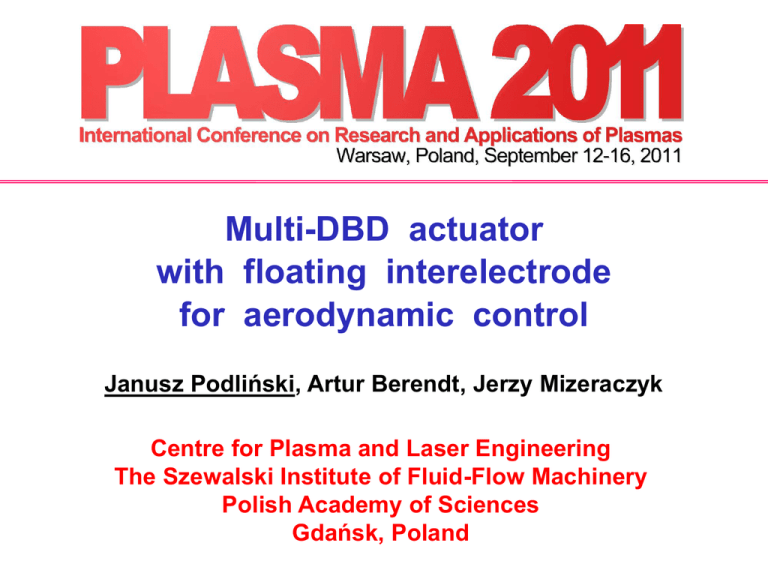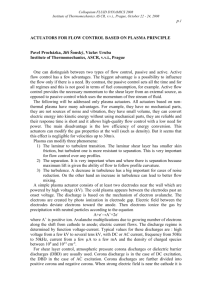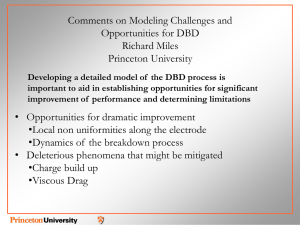Slajd 1 - Center for Plasma and Laser Engineering
advertisement

Multi-DBD actuator with floating interelectrode for aerodynamic control Janusz Podliński, Artur Berendt, Jerzy Mizeraczyk Centre for Plasma and Laser Engineering The Szewalski Institute of Fluid-Flow Machinery Polish Academy of Sciences Gdańsk, Poland Outline Dielectric Barier Discharge (DBD) plasma actuators • Applications • Design Our investigations • Electrode shape • Electrode at floating potential • Multi-DBD plasma actuator Summary 2 DBD plasma actuators DBD plasma actuator for flow modification Actuator OFF Flow Actuator ON Flow visualisation in an aerodynamic channel with a DBD plasma actuator 3 DBD plasma actuators DBD plasma actuator placed on an aerodynamic element can influence on: • Boundary layer transition • Wing tip vortex • Leading and trailing flow separation DBD plasma actuators can change parameters of the airfoils • Lift force increase • Drag force decrease • Noise reduction 4 DBD plasma actuators Top-side view of the „classic” DBD plasma actuator Cross-section of the „classic” DBD plasma actuator 5 Our investigations Experimental set-up for DBD discharge parameters and flow measurements by PIV 6 Our investigations Classic DBD plasma actuators Without electrode gap With electrode gap 20 mm Up-p=24 kV; Ip=500 mA; f =1,5 kHz Up-p= 48 kV; Ip=20 mA; f =1,5 kHz 7 Saw-like electrodes for DBD plasma actuators Saw-like electrode Example of saw-like electrode DBD plasma actuators with smooth and saw-like electrodes Smooth electrode Electrode gap 20 mm Up-p = 52 kV, f = 1.5 kHz The discharge for actuators with smooth and saw-like electrode Effect of saw-like electrode DBD starts at lower voltage More uniform discharge along electrodes 8 Saw-like electrodes for DBD plasma actuators DBD plasma actuators with smooth and saw-like electrodes Flow velocity field measured by PIV Maximum flow generated by the actuators with smooth and saw-like electrodes (d – distance between electrodes in mm) Effect of saw-like electrode Higher flow velocities generated by DBD 9 Multi-discharge plasma actuators Schematic design ‘Classic’ Multi-DBD for actuators Double DBD plasma actuator possible Multi-DBD with floating interelectrodes for actuators 10 Multi-DBD actuator with floating interelectrodes Discharge visualisation - top view Length of all electrodes: 80 mm High voltage electrode width: 10 mm HV to floating interelectrode distance: 0 mm Grounded (1) to HV electrode distance: 0 mm Floating interelectrode width: 4 mm Floating to grounded (2) electrode distance: 4 mm Grounded electrode width: 3 mm High voltage: Upp = 32 kV, f = 1.5 kHz 11 Multi-DBD actuator with floating interelectrodes Time-averaged streamlines Time-averaged streamlines of an airflow induced by the multi-DBD actuator with saw-like floating interelectrodes Airflow velocity m/s Dielectric: glass plate – 2 mm thick Length of HV and grounded electrodes: 50 mm Length of floating interelectrodes: 45 mm High voltage electrodes width: 15 mm HV and FL interelectrodes in optimum position High voltage: Upp = 32 kV, f = 1.5 kHz Floating interelectrodes width: 3 mm Floating to grounded electrode distance: 6 mm Grounded electrodes width: 3 mm Grounded to floating electrode distance: 13 mm 12 Experimental set-up for leading edge flow separation control Wind tunnel NACA 0012 model: • Chord 200 mm • Span 595 mm • Multi-DBD actuator with saw-like floating interelectrode Test section: 0.6 m x 0.46 m – 1.5 m long, Velocity 100 m/s, Turbulence level 0.1 % 13 Leading edge flow separation control - results Time-averaged flow velocity fields measured by PIV method Multi-DBD plasma actuator with saw-like floating interelectrode for leading edge flow separation control Plasma OFF – separated airflow U0 = 15 m/s Incidence = 11o Chord: 200 mm Re = 200 000 Applied HV: UHV = 15 kV fHV = 1.5 kHz Plasma ON - airflow reattachment U0 = 15 m/s Incidence = 11o Chord: 200 mm Re = 200 000 14 Summary The DBD with saw-like electrodes: • Lower onset voltage, • More uniform discharge along electrodes, • Higher airflow velocities than the DBD with smooth electrodes. The multi-DBD actuator with floating interelectrodes: • Plasma generation on a large area of the dielectric surface, • Maximum airflow velocity over 10 m/s , • Attractive for aerodynamic applications. 15







